by Winding Pathways | Sep 16, 2021 | Nature, Reflections/Profiles, Wonderment
“It’s a monster!” Payton yelled out! His fishing pole, made for a child to catch tiny fish, bent in a 180-degree arch. Somehow, amazingly, he guided the monster close enough that I could grab its lower jaw. Seconds later it was in the boat.
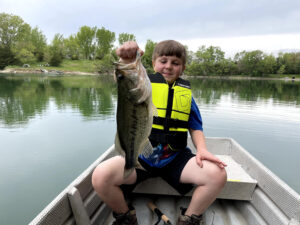
A proud fisherman.
Wow! It was a monster. 5.1 pounds is a big Largemouth bass. After carefully removing the hook, we slid her back into the water. The fish finned away, yet the memory will linger for a lifetime.
We’ve known 10-year-old Payton and his family for several years. His parents don’t fish and they want him to develop a wide range of interests. I, Rich have fished for most of my 72 years and offered to take him to a local pond. That was in the spring. We’ve since floated in my tiny row pram several times.
Mentoring. I thought I’d teach him how to fish. I sort of succeeded. At least by these skills he’s learned:
- Casting with one hand.
- Fishing without getting many tangles…..and being able to untangle most of the ones he does get.
- Learning knot tying.
- Identifying fish species.
- Picking the right lure and gently handling and releasing fish.
- Spotting mink, kingfishers, turtles, and toads.
- Collecting data. We keep length and weight records of the fish we catch.
What I didn’t realize before we started fishing was what I’d learn, including the patience needed to untangle snarls of line. I also learned some new easy-to-tie knots so I could show Payton. And, we had the chance to talk about conservation as we got to know each other.
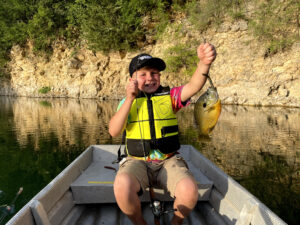
Payton has learned several skills.
Mentoring. It’s fun. Fishing has been our activity but an adult mentor can spark a kid’s interest in all sorts of activities, ranging from playing golf to fixing engines. It’s rewarding to share a hobby with a youngster…..and initiate a lifelong passion.
by Winding Pathways | Sep 9, 2021 | Garden/Yard, Nature, Pests, Trees/Shrubs
We’ve got a peach problem.
Iowa’s frigid winters don’t favor peach trees, but we’ve got a tough one in the front yard that’s withstood temps down to 30 below zero. Each May it graces our yard with pink blossoms that transform into smallish, tasty peaches that ripen around Labor Day.
We love peaches. So do deer. That means that every fall we play a waiting game with them.
Peaches look ripe a few weeks before they truly soften and ripen. When they’re hard as stones they don’t taste good. We know it. So do the deer. This starts the tricky part.
When will they be ready to pick? If we don’t harvest them at just the right time the deer will do it for us. They’ll devour every single one the night before we intend to pick. This year we ran a wide circle of wire mesh around our tree, but we know hungry deer will figure out how to foil it.
-
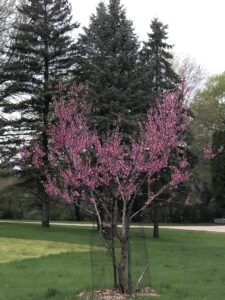
-
Each spring the fragrant pink blossoms grace our yard.
-
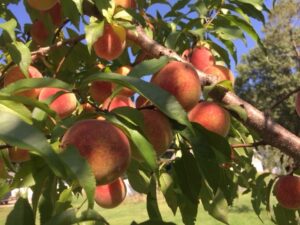
-
Deer sense when peaches are ready to eat.
As we write this on September 2nd our peaches are still hard. The deer are watching and waiting. We know because we found fresh scat just outside the wire fencing last night. We’ll let our readers know who gets the harvest.
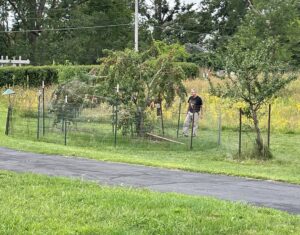
Adding extra fencing and stakes may keep the deer back.
by Winding Pathways | Sep 2, 2021 | (Sub)Urban Homesteading, Birds, Nature
A flurry of movement caught our attention. Just outside the dining room window, a tiny scrap of a bird flitted around. It wasn’t a wren, goldfinch, or sparrow. They’re around all year. Just what was it?
For most birders, May is the month to live for. Orioles, grosbeaks, tanagers, and warblers arrive as if by magic. They’re colorful, sing with gusto, and are easy to spot. It’s an exciting time, but it’s not THE ONLY exciting time.
All the colorful migrating May birds en route to northern nesting sites and the ones that stick around to nest locally are now heading south to avoid winter’s harshness. September is an outstanding birding month, but it’s also challenging.
September Birding
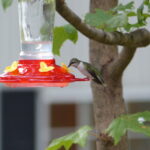
Birds stock up on high-calorie foods before their long migrations.
The birds are there but easy to miss. Many have gone through a late summer molt. They’ve replaced gaudy spring feathers with drab ones that enable them to hide better. September is a business month for birds. In May they happily court mates, but four months later the priority is beefing up their bodies for the long flight south. They dart about, often out of sight, seeking tasty insects, spiders, and seeds to fuel migration.
September birding takes patience. We find the most effective way to see birds is to sit quietly and watch. While we may slowly walk trails spotting birds in May, by September we sit on our deck in comfortable chairs, binoculars handy, and bird books and apps at the ready. We don’t find the birds. They find us, but because they don’t sing much and often look different than in Spring, identification is challenging.
Our backyard birding is exciting because we’ve diversified vegetation and have brushy areas, a prairie, a small pond, and big trees close by. However, we don’t just look there for birds. Sometimes we look upward to see soaring nighthawks, migrating raptors, and an occasional skein of Canada geese.
-
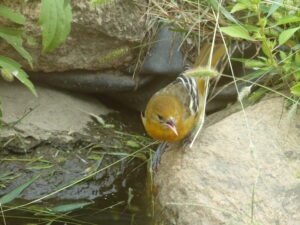
-
Birds stop for a drink and to fill up on the berries nearby.
-
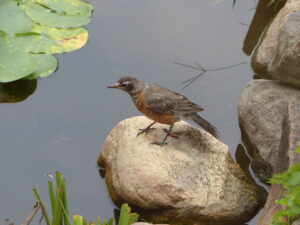
-
Keeping a wary eye, the robin cautiously gets a drink.
Identifying Fall Birds
To help with identification we use several printed bird books including the Peterson Guide and David Allen Sibley’s books. Increasingly we rely on Merlin. It’s an outstanding app produced by the Cornell University Laboratory of Ornithology. Even better, it’s free. The app easily helps identify species and shows many photos of every bird in spring/fall/juvenile/gender plumages. It also has range maps and recordings of the birds’ calls and songs. Merlin recently added a new function: sound identification. Point the phone at a singing bird and the app will help identify it by sound.
After we tentatively identify a bird, we try to confirm it by an Internet search and by consulting our birding friends. Our definitive online source is the Lab of Ornithology’s website. The site contains a vast amount of information, including how to access and use Merlin and eBird.
Easy to Keep Records
eBird allows us to record all bird species we spot in a day. Then we email results to the Lab for analysis. It’s great fun and helps the Lab research bird populations and movement.
There’s more to fall than football and leaf raking. It’s an excellent time to bird and the best birding is often the backyard.
by Winding Pathways | Aug 19, 2021 | (Sub)Urban Homesteading, Amphibians/Reptiles, Garden/Yard
Outside our dining room is a tiny pond crafted by our home’s previous owner. It’s smaller than a compact car and is the regular home of water lilies, dragonflies, and a few goldfish we stock to eat mosquito larvae. One morning we were astonished to spot a large frog partly submerged on the pond’s edge. Where did it come from and how did it get here?
We live on an ancient sand dune. Rain quickly percolates downward, so the rubber membrane at the pond’s bottom holds water that would otherwise quickly disappear. No other bodies of water are close by. Could our frog have hopped a half-mile uphill from Indian Creek? Did it come from a nearby neighbor’s pond? And, how would it have got there since we all live on a hill?
We know birds, insects and mammals find and settle in new habitats. They’re mobile and fly or walk until they spot a new home place. Frogs and turtles can walk – or hop -but they’re slow and vulnerable to predators when venturing on land.
Ask the Expert!
We didn’t know how our frog found our pond, so we asked biologist Dr. Neil Bernstein.
He responded by saying that some frogs disperse from wetland to wetland randomly, and there’s speculation that eggs can attach to waterfowl legs. His short answer was, “I don’t know”.
That’s a wise response. Science has revealed many of nature’s mysteries, but more remain unknown. Did our frog somehow sense that a tiny pond way up yonder would be a good place to risk hopping to? We don’t know but we’re certain this wandering amphibian is welcome to enjoy life at Winding Pathways.
-
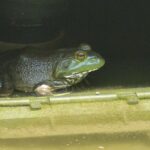
-
Waiting for lunch in the shade.
-
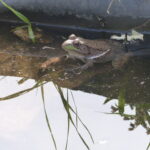
-
How the frog came here is a mystery.
-
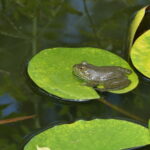
-
Resting in the sun.
-
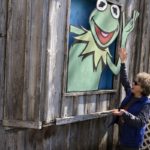
-
Leland, Mississippi is home of Kermit the Frog.
by Winding Pathways | Aug 12, 2021 | (Sub)Urban Homesteading
We’re of an age when every few years our doctor prescribes a colonoscopy. It’s not something to look forward to, but it makes perfect sense. Early detection catches cancer while there’s time to take effective medical action.
The same goes for wood stoves. Wood is our main heating fuel, and we burn several cords each winter. To keep our home safe, we hire Midtown Chimney Sweeps each June to remove soot from our chimney and do a stove and flue safety check.
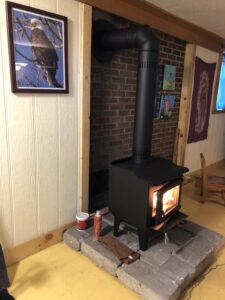
Maintaining a woodstove is like getting a periodic colonoscopy.
Burning wood can cause two types of chimney deposits. Burning unseasoned wood or restricting air coming into the stove can create a dangerous buildup of creosote. Too much creosote and soot in the chimney are a recipe for a chimney fire. They’re scary and cause homes to burn down and endanger lives.
We prevent this by burning only dry wood and burning at a fairly high stove air intake. These steps prevent the fire from smoldering all night and avoid creosote buildup. We let our fire die out in the late evening and restart it the next morning.
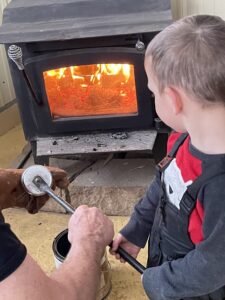
Learning to respect the woodstove.
We’ve never had a creosote buildup, but soot does lodge in our chimney. Midtown removes it early each summer so we’re ready to light the stove on autumn’s first crisp evening.
A colonoscopy reduces the odds of dying of colon cancer. Stove and chimney cleaning reduce the odds of a serious house fire. Both are smart to do.
-
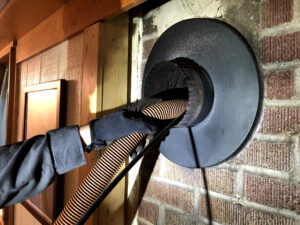
-
Midtown is careful to reduce dust as the workers clean the chimney.
-

-
The workers are prompt, thorough, friendly.
Note: Many companies do excellent work cleaning chimneys. We were not paid by Midtown Chimney Sweeps to mention their company in this blog. They simply have always done good work at our home. We encourage anyone who uses a wood stove or fireplace to keep it in good working condition and have it and the chimney cleaned regularly.
















